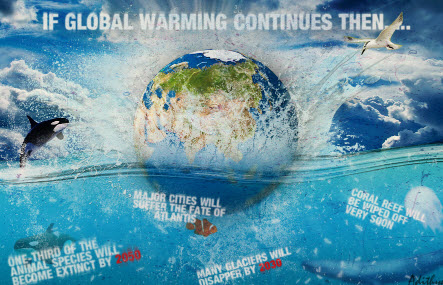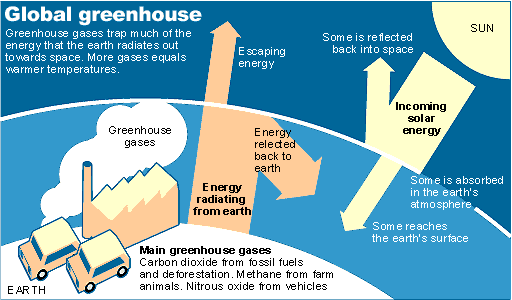GLOBAL WARMING

Unit Overview
In this unit we will about how
greenhouse gases and other pollutants contribute to global warming and other
environmental changes.†
Global Warming
Scientists who study the average
weather conditions of a region or the weather patterns that occur over many
years are referred to as CLIMATOLOGISTS. In the unit, Climate,
you learned that there were three factors that affected the climate of a
region: 1) latitude (distance from the equator); 2) topography (shape of the
land); and 3) heat absorption and release. You also learned in the unit, The Atmosphere, carbon dioxide
makes up less than 1% of the atmosphere by volume. The amount is actually only
0.03%, but CO2 is still a very important component, and important in
the process of keeping some of the sunís energy in the atmosphere.
About 50% of the incoming solar energy reaches the earthís surface, and about
15% of that is reflected back into space. These reflected infrared rays are
naturally absorbed by certain components of the atmosphere. Some are particles
like soot, dust, and water droplets. Some are gases including water vapor,
methane, ozone, and carbon dioxide. This natural process traps heat in the
atmosphere and is commonly known as the GREENHOUSE
EFFECT because the atmosphere has
the heat trapping effect like the glass walls and roof of a greenhouse. Without
the natural greenhouse effect, the average temperature of the earthís surface
would be nearly sixty degrees Fahrenheit colder than it is now!

Temperature records show that
the average temperature of the earthís surface has increased between one and
two degrees Fahrenheit since the late 1800ís and the advent of the Industrial Revolution.
There has also been an increase of about 25% in the amount of carbon dioxide
and of about 150% in the amount of methane in the atmosphere since the
mid-1800ís. Scientists attribute these increases to two factors: 1) the
increased burning of fossil fuels (coal, oil, & natural gas); and 2) the
increased clearing of land and the destruction of trees and plant life. Some
scientists propose that the increase in surface temperature, called GLOBAL WARMING, is connected to the
increase in these greenhouse gases. Computerized mathematical models are being
used to study that data and make any relationships that can be applied to
current trends.
Climatologists do not all agree on what the future may hold in light of this
data. Some predict a change in rainfall patterns, the melting of polar ice
caps, and the increase in sea level and the severity of tropical storms. This
would cause a dramatic change in the climate and shifts in animal and plant
populations possibly causing a more tropical climate in the United States.
Another group of scientists predict a warming of northern regions will result
in more snowfall and increase the size of polar ice caps. Still others are not
convinced that this is the precursor to a large climatic change but point to
data from ice core samples that this is part of a climatic cycle the earth goes
through periodically.
Efforts in the scientific community as well as in the political realm are being
put forth to slow global warming. Technology has produced many devices to more
efficiently burn fossil fuels in order to reduce greenhouse gas emissions. In
the unit, Energy Alternatives,
you studied nontraditional energy sources that donít emit greenhouse gases and
their pros and cons. Governments are being encouraged to end the massive
deforestation of tropical rain forest and to re-forest those areas. Increased
quantities of vegetation increase the recycling of carbon dioxide into oxygen
through photosynthesis.
Scientists may not agree on the eventual effects of global warming but they do
agree on one thing: global warming is a global problem and it will take
international teamwork, not just the United States, to slow it down.
For additional information on global warming click on the following web
site:† http://www.esa.int/esaCP/SEMRLH12Z0F_index_0.html
Air Pollution
While the Greenhouse Effect is
largely responsible for Global Warming, other air pollutants also add to
it.† Much like water pollution, air
pollution can be grouped into two categories.†
There are stationary sources, sources of pollution that have a fixed
location, like factories. There are also mobile sources like cars, trucks, air
planes, and trains that emitted pollutants as the move. Carbon monoxide, sulfur
dioxide, and nitrogen dioxide are all examples of primary pollutants because
they are released directly to the atmosphere through combustion of engines and
other machines.† These not only harm the
atmosphere, they can harm plant and animal life as well as our health.
Secondary pollutants are when primary pollutants react with naturally occurring
compounds.† When these pollutants attach
to water particles in the air it can come back to Earth as acid rain.† Acid rain can kill plant life, aide in erosion,
and change the chemistry of the soil.
Six Criteria Pollutants
The six most common air
pollutants are sulfur dioxide, nitrogen oxides, carbon monoxide, ozone, lead,
and particulates.
1.
Sulfur dioxide
(SO2) is a colorless, odorless gas is released form many coal plants and
industrial processes. This can cause major health issues in animals and plants
and corrode metal and paint.
2.
Nitrogen oxides
can occur in many forms in the atmosphere but largely emitted in two forms:
nitric oxide (NO) or nitrogen dioxide (NO2), both a yellow-brown to
reddish-brown gas.† Nitrogen oxides
heavily contribute to smog and can stunt plant growth. These pollutants are
emitted mostly more the burning of fossil fuels.†
3.
Carbon monoxide
(CO) is another colorless, odorless gas.†
This gas attaches to the hemoglobin in your blood. Hemoglobin is what
transports the oxygen throughout the body.†
If there is more CO than oxygen in your blood, it could lead to death.
The majority of the carbon monoxide in the atmosphere is natural occurring.† The man made CO pollution is from fires,
vehicles, and the incomplete burning of organic compounds.
4.
Ozone (O3)
is a colorless gas with a semi sweet smell. While ozone is a very important
component of the atmosphere, too much can cause damage on Earth.† Ozone can kill leaf tissue in plants and
cause eye and respiratory health problems in humans.
5.
Lead a
blueish grey heavy metal. It used to be in paint and gasoline.† Lead can cause major health problems like
cancer.† Since discovering this, lead has
been heavily reduced.††
6.
Particulate Matter (PM) is all the solid and liquid particles suspended in the air.† Some particles are so small they cannot be
seen, but many like soot, smoke, soot, or dust. Other examples of particulate
matter are asbestos and heavy metals. PM can cause respiratory issues and block
sunlight, which could lead to climate changes.
The Clean Air Act created by
the U.S. Congress to regulate air pollution and set goals of better air quality
numbers.† This act was amended in 1977
and 1990 to set new goals.† Industries
are usually fined when they are not cleaning their waste properly.
The following video
highlights four categories of air pollution: particulate pollution, chemical
air pollution, ozone pollution, and greenhouse gas pollution.
 ††† Now answer questions 1 through 20.
††† Now answer questions 1 through 20.